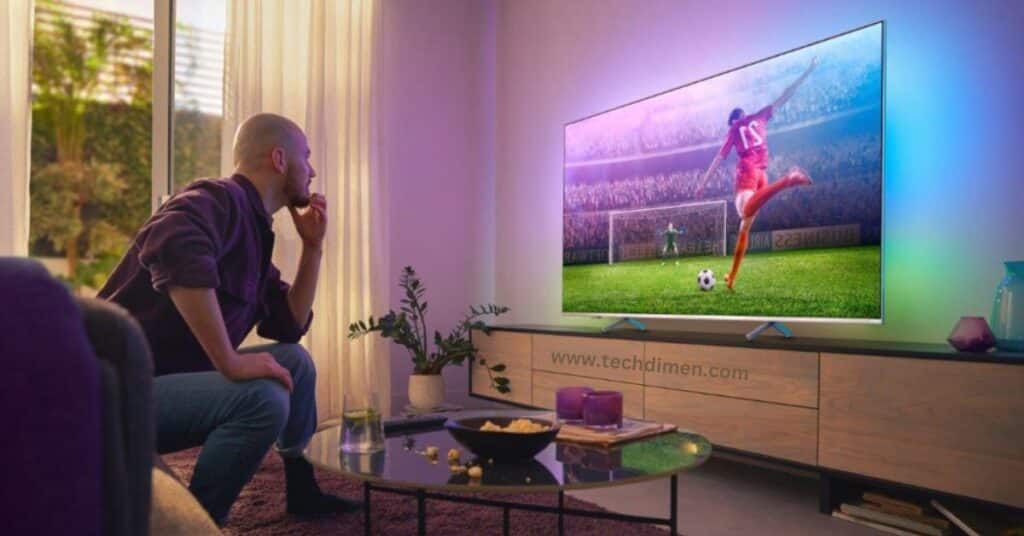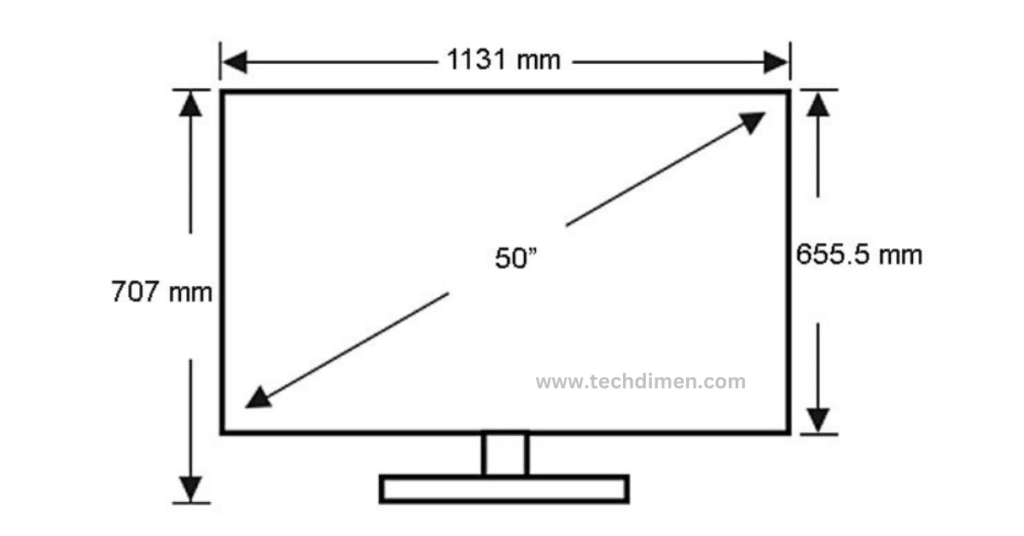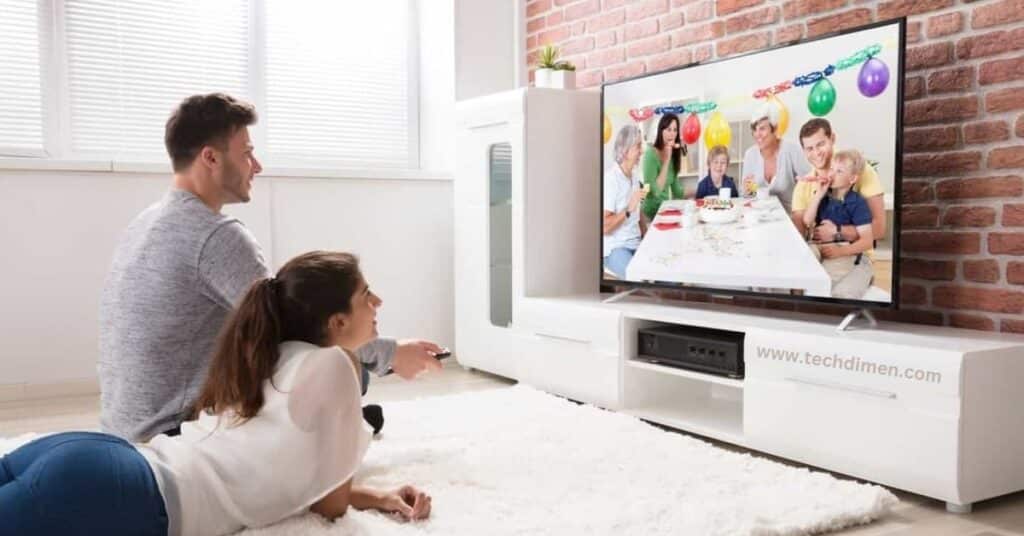When you’re in the market for a new television, one of the most crucial aspects to consider is its dimensions. The wide 50 inch TV Dimensions is a popular choice for many households, striking a balance between screen size and room space. But understanding the actual size of a Wide 50 inch TV beyond its screen diagonal is essential for proper placement, optimal viewing experience, and overall satisfaction. In this comprehensive guide, we’ll dive deep into the Wide 50 inch TV dimensions, explore the width, height, depth, and stand size, and provide practical insights to help you make an informed decision.
Understanding Actual of wide 50 Inch TV Dimensions
When shopping for a wide 50 inch TV, many people assume that the TV’s dimensions directly correlate to its screen size. However, the screen size only measures the diagonal distance from one corner of the screen to the opposite corner. The actual TV dimensions—including width, height, and depth—can vary significantly depending on the model and design.
Screen Size vs. Wide 50 Inch TV Dimensions

The screen size is a useful indicator of the viewing area, but it doesn’t tell you how much space the TV will actually take up in your room. For example, a typical wide 50 inch TV may have a screen size of 50 inches, but the TV width could range from 43 to 48 inches, depending on the bezels and frame design. The height dimension and depth measurement are also critical for determining where and how the TV can be placed.
Measurement Guide
To measure your TV accurately:
- Width: Measure from the left edge to the right edge, not including any bezels.
- Height: Measure from the bottom to the top of the TV, including the frame.
- Depth: Measure from the front of the screen to the back of the TV, including any protrusions like the stand.
Here’s a comparison table of different TV models to illustrate varying Wide 50 Inch TV dimensions:
| Model | Width (inches) | Height (inches) | Depth (inches) |
| Samsung QN50Q60AAFXZA | 44.3 | 25.4 | 2.2 |
| LG 50UP8000PUA | 44.1 | 25.7 | 2.3 |
| Sony X80J 50 Inch | 44.4 | 25.8 | 2.4 |
Note: These measurements do not include the stand size.
Breakdown of a Wide 50 Inch TV Dimensions
The width of a Wide 50 inch TV Dimensions is arguably one of the most critical dimensions, especially if you plan to fit the TV into a specific area or mount it on a wall. Most wide 50 inch TV fall within a similar width range, but slight variations exist depending on the brand and model.
CLICK HERE .if you need more informative thingsAverage width
The average TV width for a Wide 50 Inch TV typically ranges from 43 to 48 inches. This width is determined by measuring the TV from the left edge to the right edge, including the bezels but excluding any stand or wall mount.
Factors Affecting Width
- Bezels: The thickness of the bezels can affect the overall TV width. Flat panel TV with thinner bezels usually have a smaller footprint, making them a better fit for tight spaces.
- Design Variations: TV with curved screens might have a slightly different width compared to flat screens, although this difference is usually minimal.
Height, Depth, and Stand Size Considerations

While width is often the primary concern, the height and depth of a wide 50 inch TV are equally important, particularly if you’re considering a specific placement like a TV stand or wall mount.
Height and Depth of wide 50 Inch TV Dimensions
The height dimension of a Wide 50 inch TV usually falls between 25 to 30 inches. This includes the TV frame but excludes the stand. The depth measurement often ranges from 2 to 4 inches, depending on the model.
Impact on Placement
- TV Stand: If you’re placing the TV on a stand, make sure the stand is wide enough to support the TV’s base. Also, consider the TV depth to ensure it doesn’t protrude too far forward, which could affect the viewing angle.
- Wall Mount: When wall mounting, the depth measurement is crucial to determine how flush the TV will sit against the wall. Thinner TVs with minimal depth are ideal for a sleek, modern look.
Stand Dimensions
The stand size is often overlooked but can significantly impact your setup. Most TV models come with a stand that adds to the overall height and depth of the unit.
- Width with Stand: The stand can add 1 to 2 inches to the TV’s width. Ensure your TV stand or console is wide enough to accommodate this.
- Height with Stand: The stand typically raises the TV by 2 to 4 inches, which could be crucial for the viewing angle, especially if you’re sitting at a lower height.
Here’s a breakdown of the stand size for popular 50 inch TV models:
| Model | Stand Width (inches) | Stand Height (inches) | Stand Depth (inches) |
| Samsung QN50Q60AAFXZA | 33.6 | 3.1 | 8.7 |
| LG 50UP8000PUA | 36.1 | 3.3 | 8.8 |
| Sony X80J 50 Inch | 37.0 | 3.5 | 9.2 |
Placement and Viewing Considerations
The placement of your wide 50 inch TV Dimensions and the viewing distance are vital for a comfortable and immersive experience. The wrong placement can lead to discomfort or even strain your eyes over time.
Impact of Width on Placement
When considering where to place your wide 50 inch TV, whether on a stand or wall-mounted, the TV width plays a significant role. For smaller rooms, the TV’s width might limit where you can place it, especially if you’re also considering space for additional furniture like speakers or consoles.
Optimal Viewing Distance
The optimal viewing distance for a wide 50 inch TV depends on the resolution and your personal preferences. A general rule of thumb is to sit between 6.5 to 8 feet away from the TV for a 1080p resolution and between 4.1 to 6.5 feet for a 4K resolution.
Case Study: Ideal Setup for a wide 50 Inch TV dimensions
Imagine you have a living room that’s 12 feet long. To set up your 50 inch TV ideally:
- Place the TV on the longer wall to maximize the distance.
- Maintain a viewing distance of around 8 feet for optimal comfort.
- Position the TV at eye level when seated to avoid neck strain.
- Consider wall mounting to save space and reduce glare from windows or lights.
Comparing TV Widths with and without Stands
One often overlooked aspect is how much the TV width can change depending on whether the TV is mounted or placed on its stand. This difference can impact your overall setup, especially in tight spaces.
Width with Stand
When the TV is placed on its stand, the width often increases slightly due to the stand’s design. This might not seem like a significant difference, but it could affect where the TV can be placed, particularly if you’re working with limited space on a console or TV stand.
Width without Stand
Without the stand, the TV is generally narrower, making it ideal for wall mounting. Wall mounting can also give you more flexibility in terms of room placement, as the TV doesn’t need additional space for a stand.
Pros and Cons of Stand vs. Wall Mount
- Stand: Easier to set up, allows for easy access to cables, but takes up more space and might not be as secure.
- Wall Mount: Saves space, offers a cleaner look, but requires precise installation and may limit access to ports.
Additional Considerations for Wide 50 Inch TV dimensions

Beyond the basic dimensions and placement, there are a few more factors to keep in mind when choosing a wide 50 inch TV.
Weight and Mounting
The weight of a 50 inch TV can vary significantly, affecting your choice of wall mount. Most TV models in this size range weigh between 25 to 35 pounds. Ensure that your wall mount is rated to handle the TV’s weight, and always use the appropriate wall anchors for your wall type.
Cable Management
Cable management is essential for maintaining a clean, clutter-free setup. With wider TV, especially those mounted on walls, managing cables effectively can be challenging. Use cable clips, raceways, or in-wall cable management kits to keep things tidy.
Room Lighting Impact
Lighting can dramatically affect your viewing experience. For a 50 inch TV room lighting should be considered, especially if your TV is placed near windows or under bright lights. Anti-glare screens or strategic placement can help reduce reflections and enhance picture quality.
Conclusion
Choosing the right Wide 50 inch TV Dimensions involves more than just picking a screen size. By understanding the actual dimensions—including width, height, depth,
and stand size—you can ensure your TV fits perfectly in your space and provides an optimal viewing experience. Whether you decide to mount your TV on the wall or place it on a stand, knowing these details will help you make an informed decision that enhances your home entertainment setup.
Additional Resources
TV Size Calculator
Use our TV size calculator to determine the best TV size for your room, ensuring you get the perfect fit for your space.

Jhon AJS is a tech enthusiast and author at Tech Dimen, where he explores the latest trends in technology and TV dimensions. With a passion for simplifying complex topics, Jhon aims to make tech accessible and engaging for readers of all levels.







